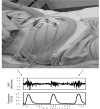Physiology and electrical activity of uterine contractions
- PMID: 17659954
- PMCID: PMC2048588
- DOI: 10.1016/j.semcdb.2007.05.004
Physiology and electrical activity of uterine contractions
Abstract
Presently, there is no effective treatment for preterm labor. The most obvious reason for this anomaly is that there is no objective manner to evaluate the progression of pregnancy through steps leading to labor, either at term or preterm. Several techniques have been adopted to monitor labor, and/or to diagnose labor, but they are either subjective or indirect, and they do not provide an accurate prediction of when labor will occur. With no method to determine preterm labor, treatment might never improve. Uterine electromyography (EMG) methods may provide such needed diagnostics.
Figures



References
-
- US Preventive Services Task Force. Guide to Clinical Preventive Services: An Assessment of the Effectiveness of 169 Interventions. Baltimore, MD: Williams & Wilkins; 1989.
-
- Brown ER, Epstein M. Immediate consequences of preterm birth. In: Fuchs F, Stubblefield PG, editors. Preterm birth: causes, prevention, and management. New York: Macmillan Publishing; 1984. p. 323.
-
- Brown ER. Long-term sequelae of preterm birth. In: Fuchs F, Stubblefield PG, editors. Preterm birth: causes, prevention, and management. New York: Macmillan Publishing; 1984. p. 333.
-
- Kao CY. Electrical properties of uterine smooth muscle. In: Wynn RM, editor. Biology of the Uterus. Plenum Press; New York: 1977. pp. 423–496.
-
- Marshall JM. Regulation of activity in uterine smooth muscle. Physiol Rev. 1962;42:213–227. - PubMed
Publication types
MeSH terms
Grants and funding
LinkOut - more resources
Full Text Sources

